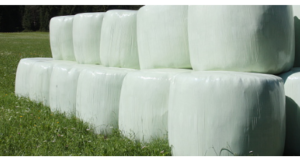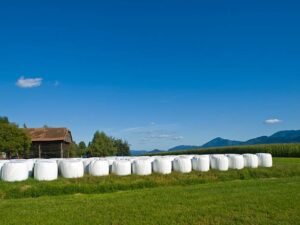Using a good quality silage wrap is essential to help preserve your forage. It prevents heat and moisture from affecting the quality of the feed and helps protect the nutrients.
In addition, it is a great way to reduce waste. In partnership with Plastic Forests, Shoalhaven City Council collects discarded silage wraps and twine for recycling into helpful farming products. For more silage wrap collection, check this out.
Collection Instructions
 Silage wrap is a plastic film used in agriculture to wrap hay or straw bales to protect them from moisture and other external elements. It also helps preserve these crops’ quality and nutritional value so they can be used as feed for animals later.
Silage wrap is a plastic film used in agriculture to wrap hay or straw bales to protect them from moisture and other external elements. It also helps preserve these crops’ quality and nutritional value so they can be used as feed for animals later.
The silage wrap is designed with an oxygen barrier and formidable strength, which allows it to create an air-tight seal around the bales. It is important to help prevent the growth of mould, which can result in ruined silage. Silage wrap is also designed to be a reflective surface, which helps keep heat off the bales.
In addition, the silage wrap is odourless and contains no pesticides. It makes it safe for both humans and animals to handle. It is also a renewable resource that farmers can use repeatedly.
Using silage wrap helps increase the production and preservation of hay, as it helps to reduce waste from spoiled forage. It also promotes controlled anaerobic fermentation, which increases the nutrition of the forage for animal consumption. Making hay can be time-consuming and labour-intensive, so silage wrap can save the farmer money and effort.
Not all silage wrap is the same, however. Some have varying layers and may contain different levels of UV protection, tact, or puncture resistance. Choosing a silage wrap that best suits the farmer’s needs is essential, as this can help ensure high-quality hay at the end of the season. For more silage wrap collection, check this out.
Shoalhaven City Council is working with Plastic Forests to collect discarded silage wrap for recycling. It is a great way to reduce the amount of waste in landfills, as the silage wrap can be recycled into new plastic agricultural products such as square pickets and poly sheets. The collected bale wrap is cleaned, shredded, and dried before being sent to two facilities in Ireland, where it is melted into pellets. These pellets are then used to make various plastic agricultural products, which can be sold back to the farming industry for reuse.
Preparation
Silage wrap is a crucial component of modern agriculture, used to preserve crops for later consumption. Made from a type of plastic known as low-density polyethylene (LDPE), it offers strength and durability. It also helps keep pests and rodents off the bales, reducing waste and saving farmers money. Additionally, LDPE is a recyclable material that reduces the amount of waste in landfills.
Before using silage wrap, it is essential to ensure the forage being covered is appropriately harvested and compacted. In addition, it should be free from sharp objects that could puncture the plastic. It is also essential to ensure that the surface where the hay is stored is clean and dry, as moisture can compromise the film’s effectiveness.
For the best results, silage wrap should be applied to bales within 24 hours of harvesting. Delaying wrapping can increase the risk of silage heating, which can lower forage quality and lead to spoilage loss. In addition, it is recommended that silage wrap be used over a layer of washed gravel, as this can help to prevent leaks and moisture from collecting underneath the wrapped bales. For more silage wrap collection, check this out.
Once a bale is wrapped, it should be secured tightly with twine. It will help to keep the plastic in place and protect it from any damage during transport or storage. Bales should be kept in a cool, dry area protected from direct sunlight and extreme temperatures.
Silage wrap can be collected for recycling at Plastic Forests, located at 21 Union Rd, North Albury. Please note, however, that the collection of silage wrap is only possible if presented in our straightforward, UV-stable Collection Bags. These bags are available at Plastic Forests and include the drop-off/recycling fee. The bags should be marked with your name and address and dropped off during our opening hours. For more silage wrap collection, check this out.

 Oxygen ingress can quickly spoil hay, decreasing nutritional value of silage for livestock. To minimise oxygen ingress, use high-quality bale wrap that creates an effective barrier against air ingression.
Oxygen ingress can quickly spoil hay, decreasing nutritional value of silage for livestock. To minimise oxygen ingress, use high-quality bale wrap that creates an effective barrier against air ingression.